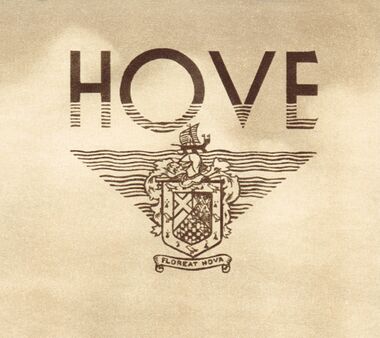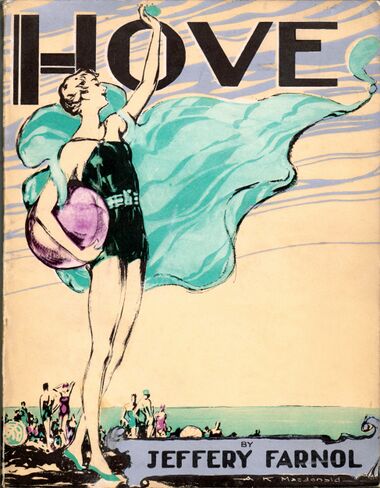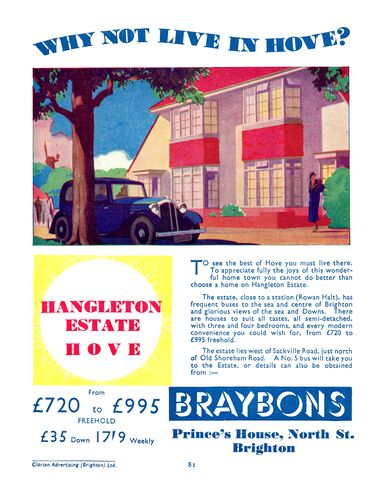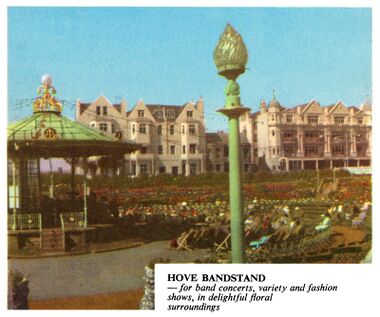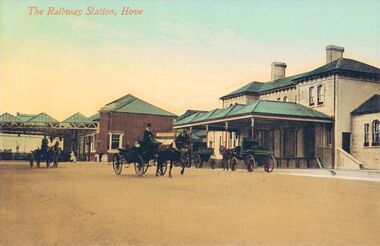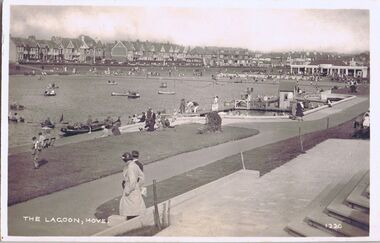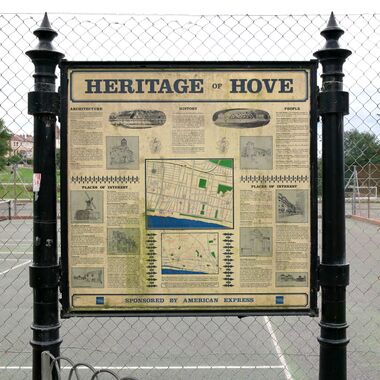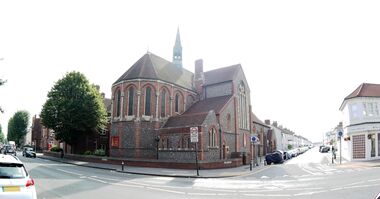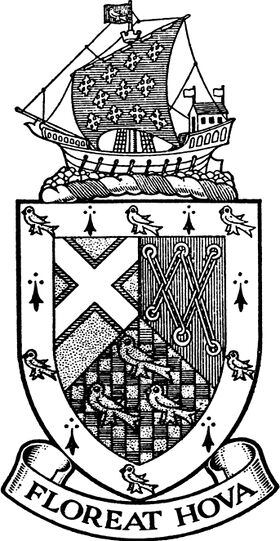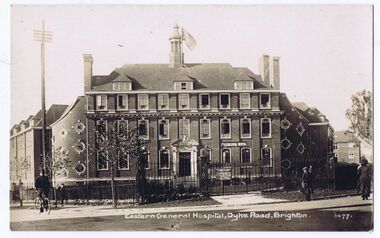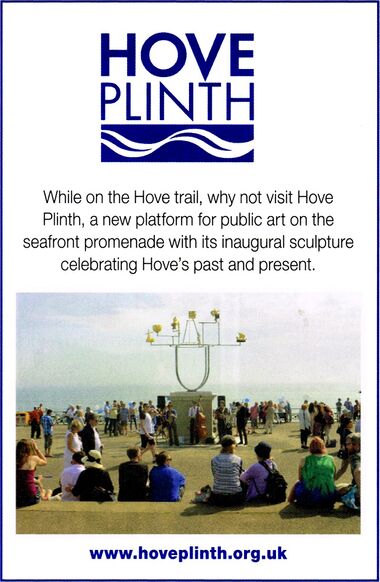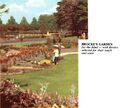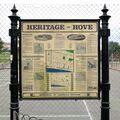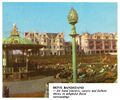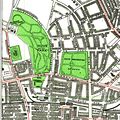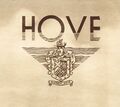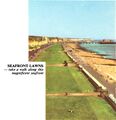Category:Hove
1936: Hove logo incorporating the coat of arms, Floreat Hova [image info]
1936: Cover of the Hove Official Illustrated Guide, Artwork by Alastair K. Macdonald (1898-1947) [image info]
1936: "Why Not Live In Hove?", Hangleton Estate, Braybons estate agents [image info]
~1961: Hove bandstand [image info]
Hove Station, with horsedrawn vehicles [image info]
1938 postmark: The Lagoon boating pond, Hove [image info]
"Heritage of Hove", a slightly outdated Hove Council information board, presumably put up some time before 1997 (since it mentions the football grounds) [image info]
St Barnabas Church [image info]
Hove coat of arms, Floreat Hova [image info]
Second Eastern General Hospital (Brighton, Hove and Sussex Grammar School) [image info]
2019: Hove Plinth [image info]
Hove is the region directly to the West of Brighton, with the border being marked on the seafront by the "Angel of Peace" statue. While it was originally a separate entity, the Borough of Hove was merged with Brighton in 1997 to become the Borough of Brighton and Hove, with the combined urban area proudly achieving official recognition as a city in 2001.
Hove has traditionally had a different character to Brighton, with a quieter and more genteel atmosphere than its brasher tourist-magnet neighbour. Prior to unification, Hovians were sometimes understandably defensive about people assuming that they lived in Brighton, the stock response being "Hove, actually".
Increasingly close cooperation and coordination between Brighton and Hove through the Twentieth Century meant that the two boroughs already operated as a single unit for for some purposes, and by 1961 the two separate official Brighton and Hove tourist guides, produced by the two respective boroughs, had been replaced by a single combined guidebook.
Origins and development
Hove (generally thought to be a derivative of "hov", meaning farmhouse or farm building) was for most of recorded history a tiny village with a church and a single road (Hove Street). By around 1800 it still only had about a hundred registered inhabitants. However, with the boom in the development of Brighton, Eastern Hove became the site of large-scale development of imposing houses for the wealthy, (arguably the Western counterpart of the developments that took place to the East of Brighton, in Kemp Town) including the classic bow-fronted Regency houses of Brunswick Square. While Kemp Town developed essentially from scratch the Hove developments quickly fused with some of the surrounding estates that all became a single area. While most of the other building away from the seafront didn't copy the smooth-faced Regency style, many of the buildings have surprisingly ornate or carved brickwork and/or terracotta tiling.
Hove Council "HOVE" information board text (1990s?)
HISTORY
Hove is separate and very different from Brighton.
... the town was was originally a fishing village near the King Alfred Centre. Between the 16th. and 18th. C. the Downland Villages of Portslade, Hangleton and West Blatchington were more important, with their Manor Houses, barns and windmills. These villages were later engulfed by the suburbs of Hove in the 1950s.
In the 1820s, the Brunswick area grew with grand homes for the wealthy, adjacent to popular Brighton. This was the era of horse and carriage, servants, and "parading" along the esplanade. Hove grew rapidly during the reign of Queen Victoria with the building of tree-lined boulevards, a grand Town Hall, hotels, parks and gardens, a gas works and brewery. Kind Edward VII spent holidays at Kings Gardens and the famous were attracted by the residential elegance and sea-air.
Hove retains its reputation as a distinguished resort with a more peaceful atmosphere than Brighton. Today, Hove is an attractive residential town, with the best in leisure and sports facilities.
ARCHITECTURE
Hove is one of the finest examples of Regency and Victorian town development in Great Britain. There are more than 500 buildings of national historic and architectural interest.
Old Hove
Traditional Old Sussex cottages are found in Victoria Cottages near the King Alfred Centre. Look for walls made of beach pebble and flint, and the ship motif on the Espalanade shelters and in the official crest – a symbol of Hove's seafaring past.
The Regency Period
This period (early 18th century) is apparent in the Brunswick Area. Look out for Ionic and Corinthian columns, bow-fronted buildings and window "Blind Boxes". The style imitates that of Classical Greece and the Renaissance. In Hove, Regency buildings are made of "Bungaroush" (brick and pebble) rendered to look like stone. In Brunswick Square, roofs are of Welsh Slate and pavements of Scottish stone flags.
The Victorian Period
This period (late 19th century) saw the building of many grand, eccentric buildings by wealthy residents. Walk around "the Avenues", the "Willett Estate" and "Cliftonville" and see Italian-style villas, mansions with massive porches and flower-pattern bricks. Look out for mosaic steps, stained glass doors, "bottle" balustrades and a variety of cast-iron railings.
Modern Hove
Some tower-blocks were built during the 1960s, but now the emphasis in on the conservation of Hove's unique heritage.
PLACES OF INTEREST
Portslade
Like West Blatchington and Hangleton, Portslade is an old "Downland Village" with small flint or pebble cottagesin the High Street and narrow "twittens" (alleyways). St. Nicholas Church is a 13th C. Norman Church with stone roof. See also "Le Carbone", a 19th C. brewery building in the High Street.
Old Churches
St. Andrews, in Church Road, and St. Leonards, in New Church Road, are two of the oldest churches in Hove. George Everest, who gave his name to Mount Everest, is buried in St. Andrews.
St. Andrews Church, Waterloo Street
Built in 1825, and designed by Sir Charles Barry who designed the Houses of Parliament in London, this Church is one of the first examples of Italianate architecture in Britain.
The Floral Clock
In Palmeira Square, this working clock is in bloom during the Summer.
Brunswick Square and Terrace
One of the greatest examples of Regency development in Great Britain. Designed by Wilds and Busby and built between 1824 and 1840. The Brunswick Estate was a private estate governed by the Brunswick Commissioners with its own police, fire services, shopping centre (the Old Market Building), Church and Town Hall (in Brunswick Square East). An Act of Parliament requires residents to paint their houses every five years.
Waterloo Arch - Old Market
The Old Market was the Brunswick Estate Shopping Centre and was surrounded by mews and "Tradesmen's" houses. The building became an indoor riding centre and the Waterloo Arch, now floodlit and restored, served as a grand entrance.
Adelaide Crescent - Palmeira Square
Designed by Decimus Burton and built in 1850-1880, the Square was to be a complete crescent, but was built as seen today – one of the finest Victorian Squares in Great Britain.
The Willett Estate
Named after the builder of national repute, this area contains yellow brick mansions with massive porches, fancy brickwork and stained glass. A visit to Eaton Road, Wilbur Road and Eaton Gardens is recommended.
The Pembroke Estate
This is a fine Edwardian area laid out by the Vallance family. Look out for bright red brick, terracotta and high chimneys. No.157 Kingsway is a fine 1934 Art Deco mansion.
Hove Museum and Art Gallery
One of Hove's grandest Victorian villas now houses the Museum and Art Gallery. The collection includes British paintings from Gainsborough and Bonnington to Sickert and Burra, together with furniture, ceramics and glass. Special sections are devoted to the Pocock Collection of pottery and porcelain, the South-East Arts Collection of contemporary craft, toys and dolls, and the history of Hove.
In front of the museum stands the Jaipur Gate, a wooden pavilion sent by the Maharajah of Jaipur to London in 1886, and re-erected here in 1926.
1825 description:
Hove is a small and pleasant Village, nearly one mile and a half from Brighton: it contains about 300 inhabitants; and fifty houses, disposed, principally, in one street, and including several respectable buildings. The Church, which is, apparently, of Norman foundation, was originally far more extensive than at present, as may be seen by the contiguous ruins. Hove is a Prebend to Chichester Cathedral.
— , E.W. Brayley, F.S.A., , Topographical Sketches of Brighthelmston and its Neighbourhood, , 1825
1838 description:
At the western extremity of Brighton, in the adjoining parish of Hove, a magnificent building arrangement has been laid out, and is rapidly advancing towards completion. The site of this grand continuation of the town, which ranks among the most favoured building speculations in Great Britain, occupies an area of 35 acres, extending 1650 feet from east to west, and 1300 feet from north to south; abutting, on the east, on the western boundary of Brighton parish; on the south, on the sea; on the west and north, on the estate of T.S.N. Goldsmid, Esq. The plan comprises Brunswick Terrace, Brunswick Square, Brunswick Place, Waterloo Street, Market Street, Brunswick Market, the Wick Road, and the New Western Road.
Brunswick Terrace consists of 42 splendid houses, in four divisions, all fronting the sea; the first containing six houses, the two next each 13, and the fourth division 10. These houses have generally 25 feet frontage, from 40 to 45 feet of depth, exclusive of external domestic offices, with stabling and coach houses erected in the rear. Brunswick Square lies between the two greatest divisions of the terrace: it extends about 700 feet from north to south, and about 300 from east to west, being open to the sea on the south side, but enclosed on the three remaining sides by 54 houses of the same general class as those on the Terrace, excepting an opening of 98 feet in the centre of the northern side, from whence a spacious road is carried in a direct line to Wick House. The foot pavement in the Square is 12 feet wide.
An act of parliament has lately been passed, appointing twenty-one commissioners to regulate the local affairs of the district.
Beyond Brunswick Terrace is now erecting "Adelaide Crescent", named after our benevolent Queen Dowager; it is yet in a very unfinished state. The esplanade at this part of the town is much frequented during the summer time, and is upwards of a mile in length, and on the very edge of the cliff, and commanding an extensive view of the ocean.
— , Saunders, , The Stranger's Guide in Brighton; Being a Complete Companion to that Fashionable Place, and the Rides and Drives in Its Vicinity., , 1838
1933 description:
The broad, well-planned avenues and drives of the Hove quarter are very admirable. Brighton's sister town is sometimes taunted with giving its visitors nothing but "air and aristocracy". It may certainly claim to do one thing more, and that is to provide an object lesson as to how a seaside town should be laid out and developed.
— , Ward Locke, , A Pictorial and Descriptive Guide to Brighton and Hove, and District, , 1933
External links
Subcategories
This category has the following 16 subcategories, out of 16 total.
B
D
G
- Gamleys (2 P, 1 F)
H
- Hove Lagoon (1 P, 4 F)
- Hove Lawns (2 F)
- Hove Park Miniature Railway (1 P, 17 F)
- Hove Station (8 F)
K
- King Alfred Leisure Centre (2 F)
R
- Regency Town House (3 F)
S
- St Anns Well Gardens (12 F)
T
- The Old Market (5 F)
Pages in category ‘Hove’
The following 11 pages are in this category, out of 11 total.
A
H
Media in category ‘Hove’
The following 80 files are in this category, out of 80 total.
- A Corner of the Lagoon (HoveIG 1936).jpg 2,500 × 1,727; 2.93 MB
- Brighton Map, cropped (Crutchleys 1860).jpg 2,669 × 1,231; 1.98 MB
- Brockes Garden for the Blind, Brighton (BHOG ~1961).jpg 1,600 × 1,437; 1.2 MB
- Climbing Boulders, Hove Park (Brighton 2018).jpg 3,000 × 1,689; 4.14 MB
- Eastern General Hospital, Dyke Road, Brighton, postcard (Rood 3477).jpg 3,000 × 1,879; 899 KB
- Entrance to Hove Park (Brighton 2018).jpg 2,000 × 1,334; 1.98 MB
- Fish Pond, St Anns Well Gardens, Hove (Brighton 2014).jpg 2,500 × 1,667; 3.48 MB
- Floral Clock, Hove (BHOG ~1961).jpg 3,000 × 1,701; 2.86 MB
- Freemantle locomotive (Hove Park Railway 2018).jpg 3,000 × 1,688; 2.06 MB
- Friends of Hove Park noticeboard (Brighton 2018).jpg 1,200 × 895; 656 KB
- Goldstone Football Ground, commemorative sign (Brighton 2018).jpg 3,000 × 1,689; 2.81 MB
- Goldstone Football Ground, map (BrightonHbk 1939).jpg 1,600 × 1,599; 1.38 MB
- Greenery, St Anns Well Gardens, Hove (Brighton 2014).jpg 2,500 × 1,667; 3.94 MB
- Greens, St Anns Well Gardens, Hove (Brighton 2014).jpg 2,500 × 1,667; 3.16 MB
- Heritage of Hove, information board, Hove Park (Brighton 2018).jpg 3,000 × 3,000; 4.9 MB
- Hove Bandstand (BHOG ~1961).jpg 1,600 × 1,335; 1.47 MB
- Hove Corporation Cedes Stoll-Dodson trolleybus, 1914 trial (Ken Allbon).jpg 2,200 × 1,480; 977 KB
- Hove Corporation Cedes Stoll-Dodson trolleybus, 1914 trial, front (Ken Allbon).jpg 1,324 × 1,600; 1.06 MB
- Hove Corporation Cedes Stoll-Dodson trolleybus, 1914 trial, rear (Ken Allbon).jpg 1,208 × 1,600; 872 KB
- Hove Floral Clock (2021).jpg 680 × 339; 104 KB
- Hove Illustrated Guide, cover (HoveIG 1936).jpg 1,947 × 2,500; 3.48 MB
- Hove Illustrated Guide, rear cover (HoveIG 1936).jpg 1,908 × 2,500; 4.27 MB
- Hove Lagoon, aerial view (HoveIG 1936).jpg 3,000 × 2,286; 4.23 MB
- Hove Park Information Board (Brighton 2018).jpg 3,000 × 1,956; 2.81 MB
- Hove Park North miniature railway signal box (JS 2017).jpg 1,200 × 675; 680 KB
- Hove Park North Station (Hove Park Railway 2018).jpg 1,200 × 676; 710 KB
- Hove Park North Station, miniature railway (JS 2017).jpg 1,200 × 900; 921 KB
- Hove Park North Station, miniature railway, riding (JS 2017).jpg 1,200 × 676; 652 KB
- Hove Park Pavilion Cafe (Brighton 2018).jpg 1,800 × 1,012; 1.7 MB
- Hove Park Railway, Public Open Days (HPR 2018).jpg 840 × 1,200; 220 KB
- Hove Park Sign (Brighton 2018).jpg 1,200 × 675; 498 KB
- Hove Park, map (BrightonHbk 1939).jpg 2,998 × 3,000; 4 MB
- Hove Plinth (AOH 2019).jpg 1,045 × 1,600; 296 KB
- Hove Seafront, aerial (HoveIG 1936).jpg 1,837 × 2,500; 3.68 MB
- Hove Station, 1880 ironwork.jpg 1,067 × 1,600; 851 KB
- Hove Station, botanical decorations, footbridge (Brighton 2014).jpg 1,467 × 2,200; 1.49 MB
- Hove Station, botanical decorations, footbridge window (Brighton 2014).jpg 3,000 × 2,000; 2.7 MB
- Hove Station, ornamental ironwork.jpg 1,600 × 1,067; 1.11 MB
- Hove, Floreat Hova, coat of arms (HoveIG 1936).jpg 1,370 × 2,648; 1.37 MB
- Hove, Floreat Hova, logo (HoveIG 1936).jpg 1,800 × 1,400; 419 KB
- Hove, Floreat Hova, logo, sepia (HoveIG 1936).jpg 2,081 × 1,849; 2.19 MB
- Information Board, St Anns Well Gardens (Brighton 2014).jpg 3,000 × 2,183; 3.24 MB
- Information plaque, St Anns Well Gardens, Hove (Brighton 2014).jpg 2,400 × 1,600; 2.57 MB
- Inter-City 125 (Hove Park Railway 2018).jpg 3,000 × 1,690; 2.11 MB
- Inter-City 125, Phoenix, side view (Hove Park Railway 2018).jpg 3,000 × 1,689; 2.1 MB
- King Alfred Recreational Centre, advert (BHOG ~1961).jpg 1,769 × 2,200; 1.11 MB
- LBSC monogrammed shield, Hove Station.jpg 1,600 × 1,067; 652 KB
- LBSCRy relief ceramic tile decoration, Hove Station.jpg 1,067 × 1,600; 1.01 MB
- Listings, The Old Market (TOM 2018-09).jpg 3,000 × 2,130; 5.91 MB
- Locomotive crane and seating (Hove Park Railway 2018).jpg 3,000 × 1,689; 1.86 MB
- Michael Gilkes and Audrey Gilkes, riding locomotive GWR 2253 at Hove Park.jpg 2,138 × 3,000; 4.14 MB
- Model Yachting, Hove Lagoon (HoveIG 1936).jpg 2,500 × 1,742; 2.82 MB
- Paths, St Anns Well Gardens, Hove (Brighton 2014).jpg 2,500 × 1,667; 3.66 MB
- Pullman locomotive 73163 (Hove Park Railway 2018).jpg 2,200 × 1,239; 901 KB
- Pullman locomotive 73163, side (Hove Park Railway 2018).jpg 1,200 × 675; 422 KB
- Queen Victoria Memorial statue, Sir Thomas Brock, Hove (HoveIG 1936).jpg 1,923 × 2,500; 3.61 MB
- Red Loco Triumph 31576 (Hove Park Railway 2018).jpg 3,000 × 1,689; 2.3 MB
- Red Loco Triumph 31576, side (Hove Park Railway 2018).jpg 3,000 × 1,689; 2.48 MB
- Regency Townhouse, Brunswick Square, Hove, left view (Brighton 2018).jpg 900 × 1,600; 923 KB
- Regency Townhouse, Brunswick Square, Hove, right view (Brighton 2018).jpg 897 × 1,600; 981 KB
- Regency Townhouse, frontage, cross-section (Bi3D 2018).jpg 2,353 × 776; 634 KB
- Riding the Rails (Hove Park Railway 2018).jpg 1,200 × 675; 562 KB
- Seafront Lawns, Hove (BHOG ~1961).jpg 2,161 × 2,229; 2.26 MB
- Seating (Hove Park Railway 2018).jpg 1,200 × 676; 471 KB
- Shoreham Airport (HoveIG 1936).jpg 3,000 × 2,316; 4.93 MB
- St Anns Well Gardens (Brighton 2014).jpg 3,000 × 2,000; 4.61 MB
- St Barnabas Church, Hove (Brighton 2014).jpg 3,000 × 1,568; 2.09 MB
- St Johns Church and Gardens (BHOG ~1961).jpg 1,600 × 1,318; 1.17 MB
- The Garden Cafe, St Anns Well Gardens (Brighton 2014).jpg 1,600 × 1,067; 1.06 MB
- The Goldstone, Hove Park (Brighton 2018).jpg 3,000 × 1,689; 5.01 MB
- The Lagoon, Hove, postcard 1220 (postmarked 1938).jpg 3,000 × 1,920; 778 KB
- The Old Market (TOM 2018-09).jpg 3,000 × 2,132; 4.08 MB
- The Old Market, Hove, Northeast corner (Brighton 2018).jpg 3,000 × 1,690; 2.5 MB
- The Old Market, North side (Brighton 2018).jpg 2,000 × 1,126; 1.11 MB
- The Old Market, signage (Brighton 2018).jpg 3,000 × 2,000; 2.26 MB
- The Railway Station, Hove, postcard (PictorialCentre 50).jpg 3,000 × 1,944; 3.26 MB
- The Tunnel (Hove Park Railway 2018).jpg 1,200 × 676; 627 KB
- The Well, St Anns Well Gardens (Brighton 2014).jpg 3,000 × 2,000; 4.89 MB
- Why Not Live In Hove, Hangleton Estate, Braybons (HoveIG 1936).jpg 2,373 × 3,000; 3.2 MB
- Wick Estate, and Spa (Crutchleys 1860).jpg 1,232 × 691; 603 KB
